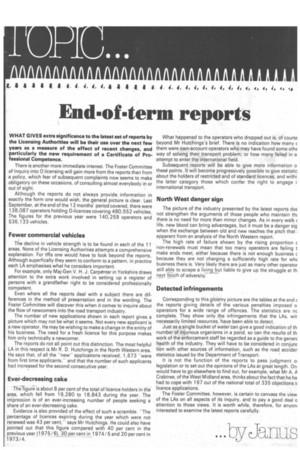End-of-term reports
Page 40

If you've noticed an error in this article please click here to report it so we can fix it.
WHAT GIVES extra significance to the latest set of reports by the Licensing Authorities will be their use over the next few years as a measure of the effect of recent changes, and particularly the new requirement of a Certificate of Professional Competence.
There is another more immediate interest. The Foster Committee of Inquiry into 0 licensing will gain more from the reports than from a policy, which fear of subsequent complaints now seems to make obligatory on these occasions, of consulting almost everybody in or out of sight.
Although the reports do not always provide information in exactly the form one would wish, the general picture is clear. Last September, at the end of the 12 months period covered, there were 138,087 operators holding 0-licences covering 480,552 vehicles. The figures for the previous year were 140,259 operators and 536,133 vehicles.
Fewer commercial vehicles
The decline in vehicle strength is to be found in each of the 11 areas. None of the Licensing Authorities attempts a comprehensive explanation. For this one would have to look beyond the reports. Although superfically they seem to conform to a pattern, in practice each LA emphasises what he considers important.
For example, only Maj-Gen V. H. J. Carpenter in Yorkshire draws attention to the extra work involved in setting up a register of persons with a grandfather right to be considered professionally competent.
Even where all the reports deal with a subject there are differences in the method of presentation and in the wording. The Foster Committee will discover this when it comes to inquire about the flow of newcomers into the road transport industry.
The number of new applications shown in each report gives a picture which may not be what it seems. Not every new applicant is a new operator. He may be wishing to make a change in the entity of his business. The need for a fresh licence for this purpose makes him only technically a newcomer.
The reports do not all point out this distinction, The most helpful LA in this respect is Mr R. D. Hutchings in the North Western area. He says that, of all the "new' applications received. 1,673 "were from first time applicants," and that the number of such applicants had increased for the second consecutive year.
Ever-decreasing cake
The figure is about 8 per cent of the total of licence holders in the area, which fell from 19,280 to 18,843 during the year. The impression is of an ever-increasing number of people seeking a share of an ever-decreasing cake.
Evidence is also provided of the effect of such a scramble. 'The percentage of licences expiring during the year which were not renewed was 43 per cent,says Mr Hutchings. He could also have pointed out that this figure compared with 40 per cent in the .previous year (1975/6), 30 percent in 1974 / 5 and 20 per cent in 1973/4.
What happened to the operators who dropped out is, of course beyond Mr Hutchings's brief. There is no indication how many c them were own-account operators who may have found some othe way of solving their transport problem; or how many failed in a attempt to enter the international field.
Subsequent reports will be able to give more information o these points. It will become progressively possible to give statistic about the holders of restricted and of standard licences, and withi the latter category those which confer the right to engage i international transport.
North West danger sign
The picture of the industry presented by the latest reports doe not strengthen the arguments of those people who maintain th there is no need for more than minor changes. As in every walk c life, new blood can bring advantages, but it must be a danger sig when the exchange between old and new reaches the pitch that i apparent from an analysis of the North Western report.
The high rate of failure shown by the rising proportion c non-renewals must mean that too many operators are failing t make ends meet, either because there is not enough business c because they are not charging a sufficiently high rate for whE business there is. Very likely there are just as many other operator still able to scrape a living but liable to give up the struggle at th next touch of adversity.
Detected infringements
Corresponding to this gloomy picture are the tables at the end c the reports giving details of the various penalties imposed o operators for a wide range of offences. The statistics are nc complete. They show only the infringements that the LAs, wit necessarily limited resources, have been able to detect.
Just as a single bucket of water can give a good indication of th number of injurious organisms in a pond, so can the results of th work of the enforcement staff be regarded as a guide to the generz health of the industry. They will have to be considered in conjunc tion with other sources of information, such as the road acciden statistics issued by the Department of Transport.
It is not the function of the reports to pass judgment oi legislation or to set out the opinions of the LAs at great length. On would have to go elsewhere to find out, for example, what Mr A. A Crabtree, of the West Midland area, thinks about the fact that he ha had to cope with 197 out of the national total of 335 objections ti licence applications.
The Foster Committee, however, is certain to canvass the view of the LAs on all aspects of its inquiry, and to pay a good deal o attention to those views. It is worth while, therefore, for anyon, interested to examine the latest reports carefully.
• • • s








































































































